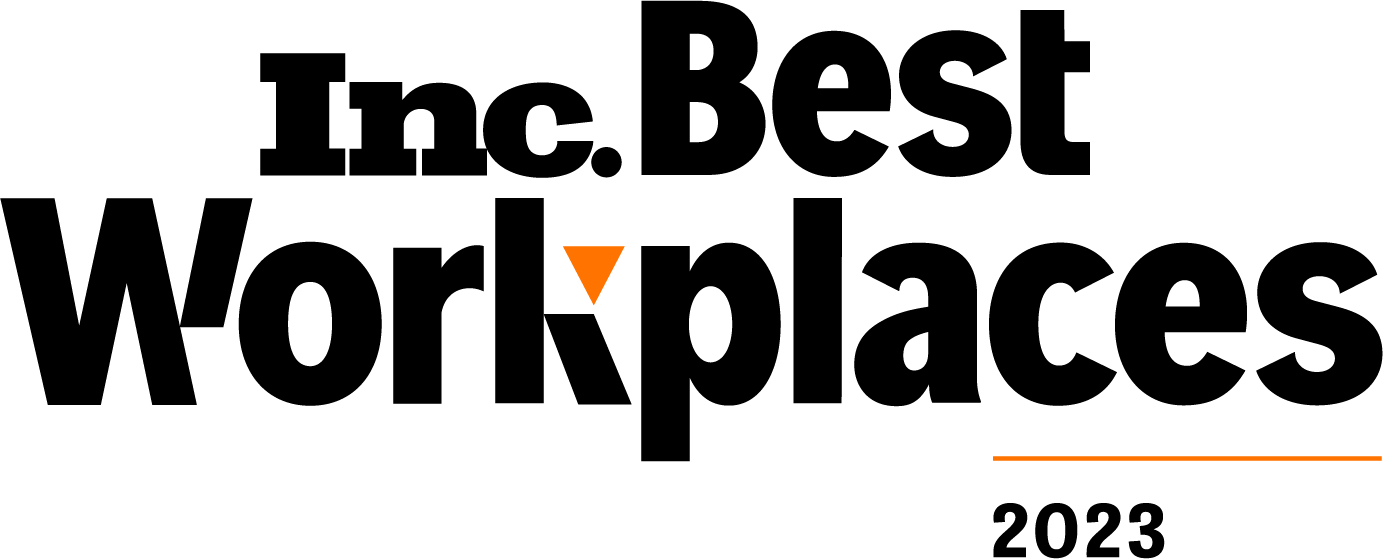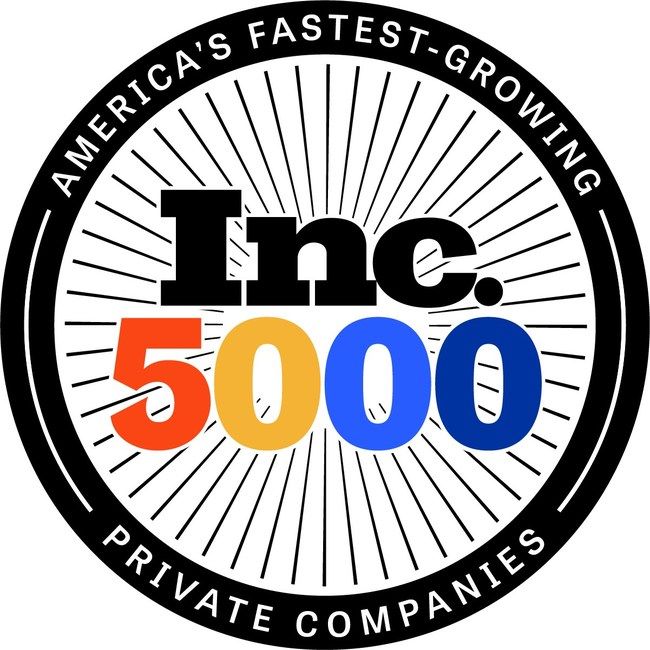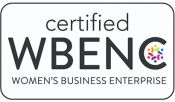Q&A with ProspHire’s Luke Laurin on Dental Practice Management
Let’s have a conversation
ProspHire brings a wealth of expertise and insights into the dynamic field of Dental Practice Management. We’re talking with Practice Leader Luke Laurin and diving into the strategies, challenges and innovation that shape the modern dental landscape.
What are the current trends and challenges in Dental Practice Management?
There are several trends we are seeing:
- Increased focus on preventive care and oral health education with patients to reduce the need for more invasive treatments. There's more emphasis on prevention rather than just treatment.
- Greater use of digital technologies like integrative practice management systems (PMS), digital imaging, digital impressions and scans, digital treatment planning and AI. This includes technologies like CAD/CAM for restorations.
- Rising popularity of cosmetic dentistry procedures like teeth whitening and veneers driven by greater consumer focus on dental aesthetics and appearance.
- Use of minimally invasive techniques and materials to preserve more natural tooth structure whenever possible. Less drilling and removing of tooth material.
- Growing use and integration of dental implants to replace missing teeth and provide anchor points for replacements like bridges and dentures.
We are also seeing a number of challenges:
- Practices are aiming to control costs, reduce overhead expenses and manage lower insurance reimbursement rates. Not focusing on these challenges can impact profitability and the ability to reinvest into implementing new technology at the clinic.
- It is challenging to keep up with rapidly evolving technologies and integrate them into the dental office and workflow. Additionally, there are significant learning curves with clinic employees and DSO support staff.
- The increasing amount of student debt for new dentists makes it harder for them to purchase and finance a practice.
- Increases in the cost of capital have led to a slowing in acquisition activity and lowering ROI, forcing some to consolidate practices.
- There are ongoing shortages of non-dental healthcare workers like dental assistants and hygienists in many areas. This makes it harder to adequately staff practices.
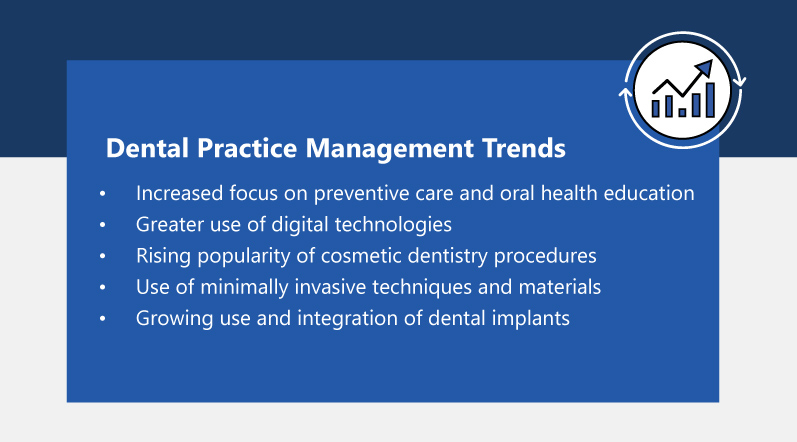
How does ProspHire support dental practices?
ProspHire’s Dental Management Practice team addresses challenges for our dental clients with innovative solutions that help streamline practice/administrative processes, improve communication and collaboration between DSOs and practices, ensure compliance, enhance revenue cycle management and bolster your reporting capabilities. We partner with you and your vendors to implement standard solutions that are fine-tuned to your unique way of operating dental practices.
Here are some of the ways we can support you through PMS implementation and optimization:
- Lead Implementation, Training and Go-Live Support
- Conduct training sessions (both online and in-person if possible) for staff on using the new software, focusing on workflows, key features and basics.
- Provide user manuals and standard operating procedure guides for workflows that are changing.
- Offer onsite go-live support when transitioning from old system to new PMS, having IT staff/PSM vendor on-site to help troubleshoot issues in real time.
- Set up feedback channels to gather input on challenges or questions about the system post implementation and provide timely responses.
- Optimization Assistance
- Review initial workflows set up in the PMS and work with practice to optimize these based on how the staff actually uses the software. Look for unnecessary steps and correct user behavior
- Examine reporting needs and ensure correct reports are being generated and used to support decision making around patient care, inventory, billing etc. Set up new reports as needed
- Conduct usage reviews to identify additional PMS features that could streamline workflows. Offer recommendations and end-user training.
- Ongoing Support
- Field staff questions and respond to system issues. This includes troubleshooting error messages, fixing configuration bugs, resolving login issues etc.
- Set up system for feature requests/enhancement suggestions from dental practice and prioritize these change requests based on impact to operations and effort required to complete.
- Maintain PMS with regular software patches, updates and bug fixes to improve stability and performance and provide release notes of changes to end-user community.
- Workflow Redesign and Improvement
- Discovery, Analysis and Redesign
- Conduct interviews and shadow staff to map out current workflows, identify bottlenecks and improvement opportunities.
- Review relevant metrics and key performance indicators (production, patient cycle time etc.).
- Document findings in process maps and improvement recommendations report.
- Facilitate working sessions with dentists and staff to redesign workflows based on findings.
- Consider opportunities to standardize processes, eliminate non-value steps and improve technology integration.
- Develop updated process documentation and job aids once new workflows are finalized.
- Discovery, Analysis and Redesign
- Workflow Implementation
- Provide staff training on changes to workflows, systems and responsibilities.
- Ensure forms, checklists and other documents align to support new workflows.
- Project team members remain available onsite during rollout to answer questions and resolve transition issues.
- Ongoing Workflow Refinement
- Gather staff feedback regularly post-implementation to identify remaining pain points.
- Continuously review metrics for target areas not yet hitting goals and make minor tweaks.
- Conduct refresher training on updated workflows if major gaps are observed.
- Clinical Operations Management
- Staffing & Scheduling
- Help dental practices create schedules that maximize provider time while ensuring adequate coverage for projected patient demand. Adjust as needed based on cancellations, no-shows, emergencies, etc.
- Develop a staffing plan tied to a schedule that allows for proper patient handoffs, task distribution across dental assistants and hygienists and coordination with front office team.
- Patient Flow & Experience
- Review office layout and patient flow to identify opportunities to improve bottlenecks and lag times and provide recommendations.
- Ensure schedule allows sufficient time for procedures while avoiding excessively long patient cycle times. Adjust slots if needed.
- Offer front-office optimizations for phone interactions and in-office exchanges to deliver positive patient experiences and that correct information is collected during scheduling and registration.
- Quality & Safety Protocols
- Provide templates for clinical operation policies and protocols around infection control, medical emergencies, documentation etc.
- Implement checklists and reminders to verify compliance with dental regulations and quality control procedures.
- Coordinate OSHA and HIPAA training logistics with practice safety officer.
- Performance Reporting
- Help leadership define relevant KPIs to track patient access, cycle time, cancellation rate, procedure volume etc.
- Set up dashboards and automated reporting to distribute for consistent monitoring of operational performance.
- Identify areas not meeting targets and facilitate problem-solving initiatives to resolve.
- Staffing & Scheduling
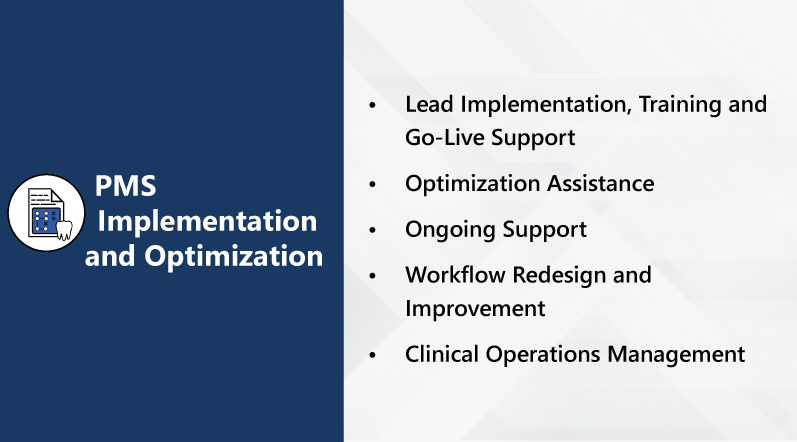
Can you share an example of a successful cost-saving measure or revenue enhancement strategy you’ve advised dental practices to adopt?
One effective strategy is the adoption of modern technologies to streamline operations, enhance patient experience and improve overall efficiency. While the initial investment in technology may seem significant, the long-term benefits often outweigh the costs. Improved efficiency and patient satisfaction can lead to increased revenue and reduced operational costs contribute to overall savings. It's essential for dental practices to carefully evaluate their specific needs and select technologies that align with their goals and patient demographics.
Additional examples of cost-saving revenue enhancements include:
- Offer cosmetic dentistry or whitening services. These are often paid directly out-of-pocket so increase profitability.
- Provide membership plans tied to regular exams and preventive care. Steady recurring revenue stream.
- Upsell elective procedures during checkups. Many patients don't think of upgrades until prompted.
- Expand social media marketing and online reputation management. Drives new patient growth and better word-of-mouth.
- Offer patient financing plans through vendors. Increases ability for patients to purchase bigger ticket treatments.
- Pay attention to legacy AR and devote a task force / team-based approach.
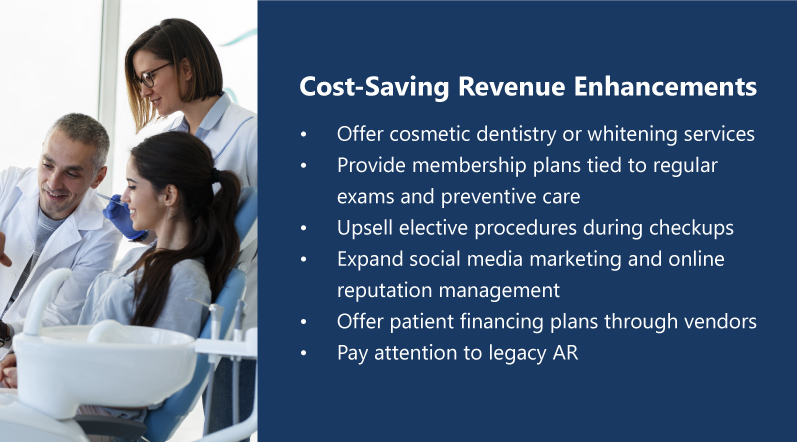
How do you stay up to date with the latest industry trends and best practices in dental practice management?
Staying informed is an ongoing process and a combination of these is often the most effective approach: regularly reviewing materials and guidance from ADA and state/local dental associations; attending major dental conventions and conferences; meeting with technology vendors for software previews and demos of emerging tools and shadowing dental contacts in their cutting-edge practices. It's crucial to assess the credibility of the information sources and tailor efforts to the specific needs and goals of the dental practice.
What is your approach to helping dental practices streamline their administrative and operational processes to improve efficiency?
Here is a comprehensive approach I would recommend to help dental practices streamline processes and enhance efficiency:
- Conduct Thorough Practice Assessment
- Review office layout and patient workflows
- Shadow staff to understand current roles/duties
- Identify any redundant efforts or bottlenecks
- Evaluate Use of Technology
- Assess what software/tools are currently utilized
- Determine opportunities to better leverage technology (imaging, cloud storage, automation tools etc.)
- Standardize Common Processes
- Document consistent protocols for hygiene, sterilization, patient intake etc.
- Create procedure manuals and templates for training
- Implement Paperless Systems
- Switch charts, forms, Rx etc. to structured digital formats
- Install tablet sign-in, intra-office messaging, cloud-based document management
- Examine Dental Coding/Billing Practices
- Ensure accurate CDT coding for maximum insurance reimbursement
- Provide ongoing coding education to billing staff
- Strategize Staffing Plans and Roles
- Cross-train where helpful to increase flexibility
- Consider expanded roles for hygienists and assistants
- Track KPIs for Continuous Improvement
- Key metrics like chair utilization, case acceptance rates, accounts receivable
- Make adjustments based on practice data
Implementing these strategies requires a collaborative effort and a commitment to ongoing improvement. Regularly reassess and adjust processes based on feedback, technological advancements and changes in industry standards to ensure long-term efficiency gains.
In what ways do you guide dental practices in ensuring compliance with industry regulations and maintaining high standards of patient care?
Maintaining rigorous compliance and high care standards is a top priority when supporting dental practices and ProspHire can play a crucial role in guiding the practices to ensure compliance with industry regulations and maintain high standards of patient care. Here are some of the ways we can support:
- Stay constantly up to date on changing regulations from OSHA, CDC, ADA and state dental boards and relay important updates to the practice.
- Conduct regular reviews with the practice to identify any areas of vulnerability or gaps related to infection control, radiography safety, data security, etc and develop action plans.
- Research and vet vendors carefully from both compliance and quality standpoints before recommending partnerships.
- Develop easy-to-follow protocol guidelines and visual aids for display in clinics regarding proper PPE use, disinfection techniques, etc.
- Schedule annual or bi-annual practice infection control audits using established assessment frameworks to systematically identify opportunities.
- Monitor patient review/rating platforms along with internal surveys to benchmark satisfaction and care experience.
- Develop staff continuing education curriculums covering both hard and soft skills to reinforce stellar care delivery.
- Guide the design and scheduling of clinical spaces to allow abundant time for complete sterilization/disinfection between patients.
- Ensure clarity on latest regulations around digital patient record storage systems including frequent encrypted backups.
- Update informed consent forms and advise on appropriate patient documentation procedures.
- Promote high standards by comparing the practice against quantified benchmarks on key parameters.
ProspHire’s Dental Practice Management team can empower dental practices to navigate complex regulatory landscapes, uphold high standards of patient care and implement continuous improvement processes. This collaborative approach helps practices not only meet regulatory requirements but also excel in delivering quality dental services.
What key performance indicators do you use to measure the success and progress of dental practices you work with?
Measuring the success and progress of a dental practice involves tracking key performance indicators (KPIs) that reflect various aspects of the practice's operations, financial health and patient satisfaction. Here are some key performance indicators that we recommend assessing the success and progress of dental practices, including clinical and operational metrics:
Clinical KPIs:
- Treatment acceptance rates - % of recommended procedures ultimately performed
- New patient conversion rates - % that schedule follow-up from inquiries
- Recall compliance rates - % of patients following maintenance intervals
- Cancelation and no-show rates
- Patient retention rates year-over-year
Operational KPIs:
- Production per provider/hygienist - tracks revenue contribution
- Accounts receivable days outstanding - gauge collection efficiency
- Patient wait times - ensures prompt service
- Schedule effectiveness - measures how well appointment slots are filled
- Insurance claim acceptance rates - monitors billing accuracy
- Cost per patient visit - manages practice overhead
- Rating platform reviews and survey feedback - indicates patient satisfaction
We collaborate with dentists to determine the optimum targets for each KPI based on practice goals and then build customized dashboards that compile the data points from electronic records, billing systems and patient platforms to allow for clear tracking over time. Reviewing the insights together enables data-driven decisions to continuously refine strategies and operations.
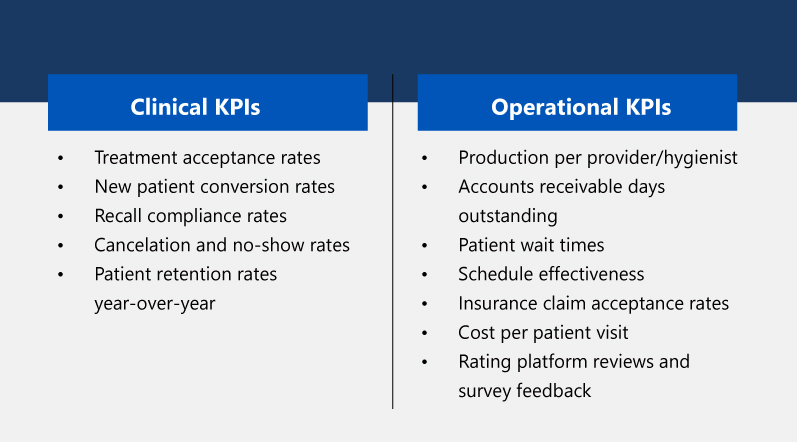
How do you tailor consulting services to meet the unique needs and goals of each dental practice you serve?
Our approach always starts with developing a deep understanding of each dental practice's unique set of circumstances, priorities and objectives. From there, tailoring the unique needs and goals of each practice is essential for providing effective guidance and support. Here are a few key steps and strategies:
- Goal-setting collaborations – Facilitate sessions to define practice vision, targets for growth/profitability, areas for improvement.
- Custom practice analyses – Conduct assessments aligned to established goals, focused specifically on SWOT variables, operations data, patient metrics.
- Targeted execution planning – Develop strategies and detailed project plans based directly on the practice’s most pressing identified opportunities.
- Personalized coaching services – Provide regular guidance aligned to practice strengths, culture and growth pace, adjusting as dynamics shift.
- Differentiated reporting tools – Design KPI dashboards indexing indicators like production, collections, ratings etc. per the practice’s key areas of focus.
- Hand-picked recommendations – Curate technologies, solutions and vendor partnerships appropriately suited to support the practice’s priorities.
- Ongoing innovation – Continually suggest fresh, relevant ideas tailored to the practice's evolving objectives.
The most impactful solutions emerge when every aspect stems from a complete understanding of the practice's unique starting point challenges and aspirations for the future. Our personalized approach enhances the likelihood of successful outcomes and long-term collaboration.
How is ProspHire positioned to assist dental practices to stay ahead of the industry curve?
We aim to help dental practices stay ahead of the industry curve by providing tailored solutions from strategic planning to technology integration to performance optimization to staff training and development. The combination of broad industry perspective and personalized practice partnership enables us keep clients on the cutting edge.
Connect with me today for more details on our services, methodologies and industry-specific expertise.
ProspHire
216 Blvd of the Allies, Sixth Floor
Pittsburgh, PA 15222
412.391.1100
[email protected]
Quick Links
© 2024 ProspHire, LLC. All Rights Reserved / Terms of Use / Privacy Policy






